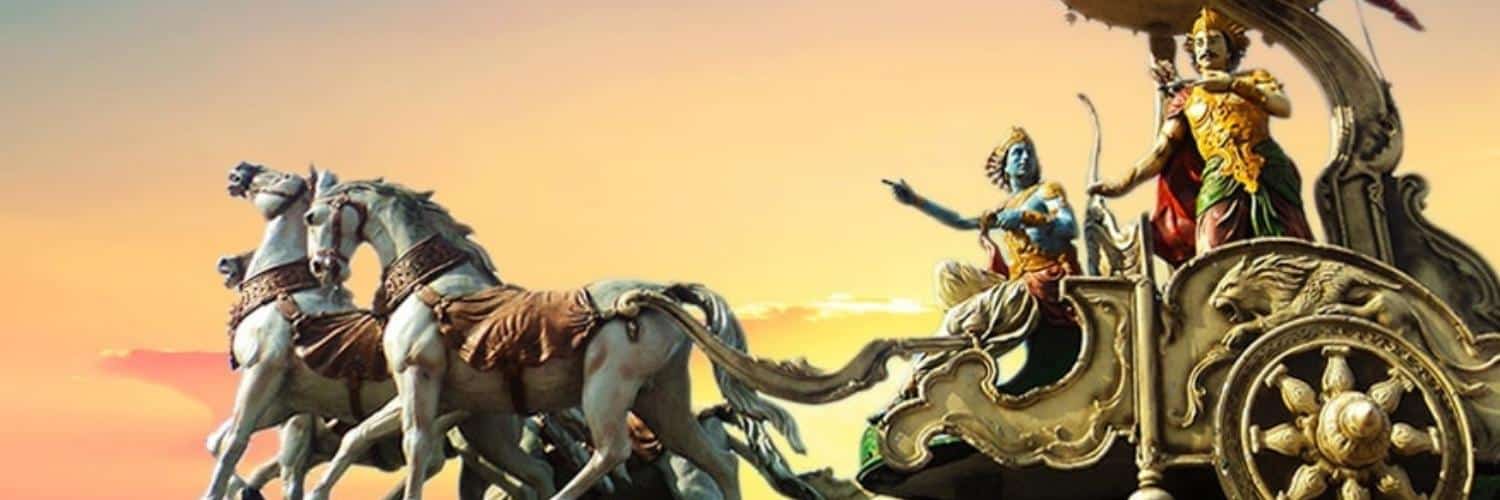
This Self is not born, nor does it perish. Self-existent, it continues its existence forever. It is birthless, eternal, changeless, and ever the same. The Self is not slain when the body dies. —The Bhagavad Gita (2:20)
The Bhagavad Gita (the song of God) is an ancient Hindu scripture excerpted from the Mahabharata, the longest epic in the world. It is sometimes referred to as the Hindu Bible, as it is by far the most popular and well-known Hindu scripture.
The book is mainly a conversation between Arjuna and his charioteer Krishna, who is actually an incarnation of God, as they are about to fight in a war over a kingdom. Arjuna does not wish to fight because many of the people on the opposing side are his friends and family. Krishna, however, explains that he has to fight, because it is his dharma, or duty, since the kingdom is rightfully his and his brothers’.
Krishna then goes on to explain the different paths to God, telling Arjuna that since he is a warrior, his path to God is through selfless action, and if he backs out of that duty by refusing to fight, he is actually moving away from God. If he fights, though, he will be victorious even if he is killed, because he will have done his duty, thereby bringing himself closer to God.
 On the surface this story is simple, but there is deep symbolism behind it. Each of the main characters on both sides of the war symbolize different qualities. It would be too long to write all of them here, but Swami Kriyananda goes over them in detail in his book, The Essence of the Bhagavad Gita.
On the surface this story is simple, but there is deep symbolism behind it. Each of the main characters on both sides of the war symbolize different qualities. It would be too long to write all of them here, but Swami Kriyananda goes over them in detail in his book, The Essence of the Bhagavad Gita.
Essentially, the people on Arjuna’s side, called the Pandavas, represent spiritual qualities like devotion and will power, whereas the opposing family, called the Kauravas, represent lower qualities such as desire and attachment. Arjuna’s reluctance to battle his relatives represents the reluctance of devotees to get rid of their lower tendencies which they see as an essential part of their self.
Krishna’s role, as representative of God, is to explain that we must “kill” those lower qualities if we are to merge with God. He wants us not to identify with them, but to see them as temporary flaws that can be overcome through spiritual practices. His role is also to explain that there are different ways to God depending on a person’s natural tendencies.
Knowing the deeper meaning behind the Gita makes it much more helpful in aiding us on the spiritual path. Taking it literally, we can still benefit from Krishna’s description of the different yogic paths and how to perform each one correctly, but we miss out on the understanding that, in order to progress on the yogic path, we need to stop clinging to our lower qualities with the excuse that they are part of who we are. Ultimately we are souls without any good or bad qualities. We are satchitananda: existence, consciousness, ever-new bliss.
Try This
On a piece of paper, draw a circle and write your name in it. Then draw lines going out from the circle, and at the end of each line write a positive or negative self-definition. Some examples would be: intelligent, lazy, passionate, calm, restless, devoted, etc. Then get some scissors and cut through all the lines, mentally letting go of all those self-definitions. Affirm that in essence you are none of those things, that one day you will transcend every limitation and definition.
Resources
- Video Series: Esssence of the Bhagavad Gita with Swami Kriyananda
- Book (Paperback, Audio & Ebook): Essence of the Bhagavad Gita by Swami Kriyananda

4 Comments
This is a wonderful article…thank you for sharing.
Well done, dear Radhika!